ISSN ONLINE(2278-8875) PRINT (2320-3765)
ISSN ONLINE(2278-8875) PRINT (2320-3765)
B.Vamsi Krishna 1, K.Priyanka2
|
| Related article at Pubmed, Scholar Google |
Visit for more related articles at International Journal of Advanced Research in Electrical, Electronics and Instrumentation Engineering
Irrigation refers to the supplying water to the dry land as a supplementation of rain water. It is mainly aimed for cultivation. There are various types of systems of irrigation practices in different parts of India. Irrigation in India is carried on through wells, tanks, canals, Perennial canal; Multi-purpose river valley projects etc. Irrigation can be defined as human manipulation of the hydrologic cycle to improve crop production and quality and to decrease economic efforts of drought. Irrigation is the artificial application of water to plants for their growth and maturity. Irrigation water is supplied to supplement the water available from rainfall and the contribution of soil moisture from ground water. Irrigation water can come from nearby rivers or underground water (groundwater) or storage ponds specifically designed to collect High River flows during winter. Pipes, channels and wells dug into the ground allow water to be taken from its source to the farms, vineyards and orchards where it will be used. Today a diverse range of ever-evolving technologies exist to efficiently apply irrigation water to crops. How much water is used depends on the type of crop, the soil in which the crop is being grown and the amount of rainfall in that area. Rainfall is the primary sources of water for irrigation. It is not available though out the year. The stored rain water either in tank or in subsurface is used as resources of irrigation water for an indefinite period. Following are the sources of irrigation water.
Keywords |
| ARM, GSM, Sensors-LDR, Soil, Temperature, Gas, Humidity. |
INTRODUCTION |
| Wireless Sensor Networks (WSN) have been the subject of research in various domains over the past few years and deployed in numerous application areas. WSN is seen as one of the most promising contemporary technologies for bridging the and virtual world thus, enabling them to interact. A WSN is composed of a number of sensor nodes, which are usually deployed in a region to observe particular phenomena in a geospatial domain. Sensor nodes are small stand alone embedded devices that are designed to perform specified simple computation and to send and receive data. They have attached to them a number of sensors, gathering data from the local environment that is being monitored. WSNs have been employed in both military and civilian applications such as target tracking, habitant monitoring, environmental contaminant detection and precision agriculture.Rainfall is the primary sources of water for irrigation. It is not available though out the year. The stored rain water either in tank or in sub-surface is used as resources of irrigation water for an indefinite period. Following are the sources of irrigation water. Water is one of the most precious commodities in the world and it needs to be preserved for future generations. |
| Irrigation is one of the main water consuming industries. It has been estimated that the world’s irrigation efficiency is less than 40 percent. In order to improve irrigation efficiency, it is important to monitor the soil Volumetric Water Content (VWC) to avoid over watering plants. Over watering also causes fungal diseases and other infections in plants. Therefore irrigation monitoring is one of the critical factors in a vineyard management system. |
| Surface water: It may be by flowing river or from still waters of tanks, ponds, lakes, pools or artificial reservoirs such as dams, barrages and diversionary bunds with different storage capacity. |
| Ground water: Water stored in the underground is known as groundwater. |
II. EXCITING WORKS |
| Irrigation refers to the supplying water to the dry land as a supplementation of rain water. It is mainly aimed for cultivation. There are various types of systems of irrigation practices in different parts of India. Irrigation in India is carried on through wells, tanks, canals, Perennial canal, Multi-purpose river valley projects etc. An adequate water supply is important for plant growth. When rainfall is not sufficient, the plants must receive additional water from irrigation. Various methods can be used to supply irrigation water to the plants. |
The various types of Systems of Irrigation practiced in India: |
1. Well Water Irrigation system: |
| Wells are mainly found in U. P., Bihar, Tamil Nadu etc. there are various types of wells—shallow wells, deep wells, tube wells, artesian wells etc. From the shallow wells water is not always available as the level of water goes down during the dry months. Deep wells are more suitable for the purpose of irrigation as water from them is available throughout the year. Tube wells are also used for irrigation purposes. A deep tube well worked by electricity, can irrigate a much larger area (about 400 hectares) than a surface well (1/2 hectares). Tube wells are mostly used in U.P., Haryana, Punjab, Bihar and Gujarat. In Rajasthan and Maharashtra, artesian wells are now supplying water to agricultural lands. |
 |
2. Tank Water Irrigation system: |
| In the Deccan, reservoirs are made by constructing dams. This system is greatly adopted in the States of Tamil Nadu, Andhra Pradesh, and Karnataka etc. In Northern India also, tanks are constructed for storing water. From all these tanks, water is carried to the fields through canals. |
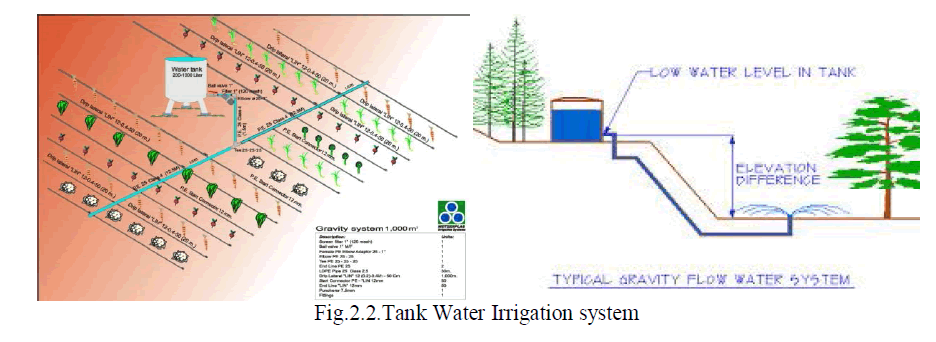 |
3. Inundation Irrigation system: |
| Canal irrigation is playing a vital role in Indian agriculture. It canal near about 42% of total irrigated land. In many places during the rainy season, there is flood in the rivers. The flood water is carried to the field through canals. These canals are found in W.B., Bihar, Orissa, etc. They supply water only when there is flood in the rivers, and therefore, are of no use during the dry season when water is required most. |
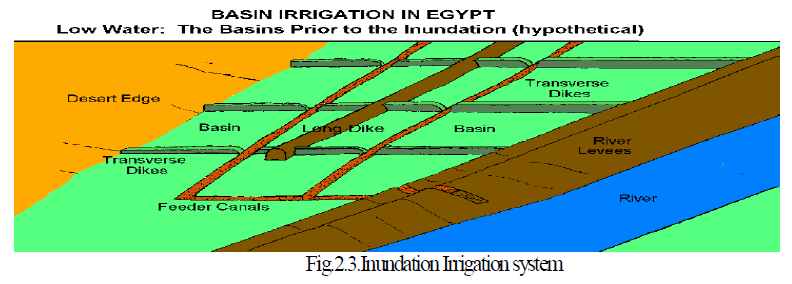 |
4. Perennial canals Irrigation System: |
| In order to supply water throughout the year, reservoirs are constructed for storing water. From these reservoirs, water can be supplied to the fields whenever there is demand for it. So this system of irrigation ensures supply of water in all season. This type of perennial canal is found mostly in Punjab, U.P., and Tamil Nadu. |
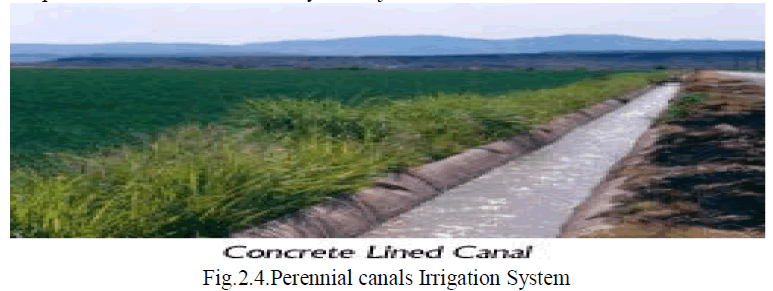 |
III. PROPOSED EMBEDDED SYSTEM DESIGN |
| The aim of this project is to provide an efficient solution for automatic control of irrigation motor for illiterates. Now a day’s technology is running with time, it completely occupied the life style of human beings. Even though there is such an importance for technology in our routine life there are even people whose life styles are very far to this well known term technology. So it is our responsibility to design few reliable systems which can be even efficiently used by them. This basic idea gave birth to the project cell phone controlled soil moisture sensor. Here the automation process is done through the micro controller based technology. The GSM Based Smart Irrigation System is a project in which we get continuous up to date status of the operation carried out in field (Farms) in the form of SMS as well we can add other systems such as LCD displays, sensors, Burglar alarms, soil sensor and Smart Controllers suitable for the particular field. |
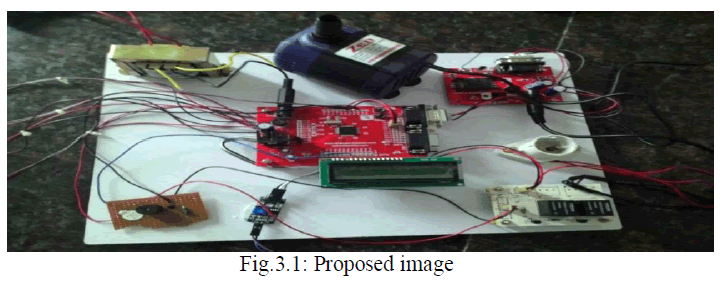 |
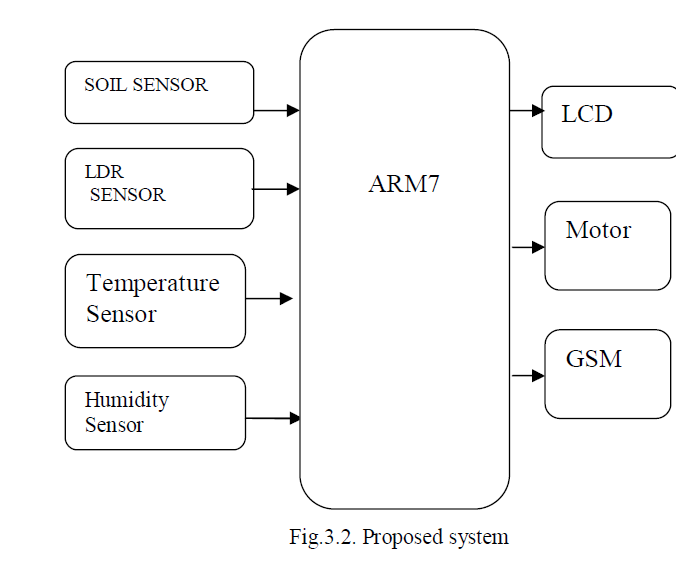 |
3.1. Proposed ARM RISC Architecture |
| ARM designs microprocessor technology that lies at the heart of advanced digital products, from mobile phones and digital cameras to games consoles and automotive systems, and is leading intellectual property (IP) provider of highperformance, low-cost, power-efficient RISC processors, peripherals, and system-on-chip (SoC) designs through involvement with organizations such as the Virtual Socket Interface Alliance (VSIA) and Virtual Component Exchange (VCX). ARM also offers design and software consulting services. |
Features: |
| ïÃâ÷ Load/store architecture |
| ïÃâ÷ A 16x32-bit register |
| ïÃâ÷ Mostly single-cycle execution |
3.2. Cellular Technology |
| This term, often used for all wireless phones regardless of the technology they use, derives from cellular base stations that receive and transmit calls. Both cellular and PCS phones use cellular technology. Cellular Technology enables mobile communication because they use of a complex two-way radio system between the mobile unit and the wireless network. It uses radio frequencies (radio channels) over and over again throughout a market with minimal interference, to serve a large number of simultaneous. |
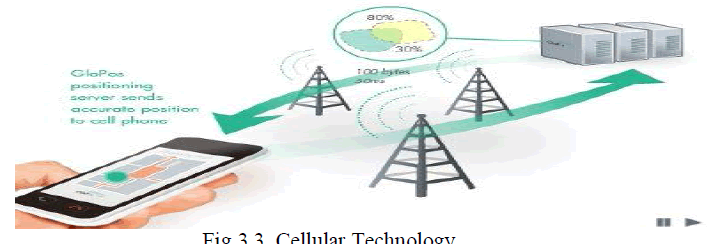 |
3.3. Soil Sensor |
| The soil moisture sensor (SMS) is a sensor connected to an irrigation system controller that measures soil moisture content in the active root zone before each scheduled irrigation event and bypasses the cycle if soil moisture is above a user- defined set point. A soil moisture sensor measures the quantity of water contained in a material, such as soil on a volumetric or gravimetric basis. To obtain an accurate measurement, a soil temperature sensor is also required for calibration. |
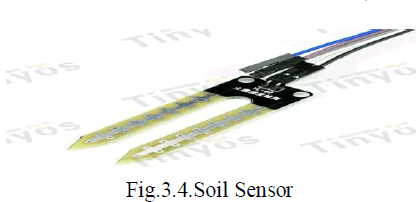 |
3.4. Weather Sensor |
| A temperature sensor is a device, typically, a thermocouple or RTD that provides for temperature measurement through an electrical signal. A thermocouple (T/C) is made from two dissimilar metals that generate electrical voltage in direct proportion to changes in temperature.The LM35 series are precision integrated-circuit temperature sensors, whose output voltage is linearly proportional to the Celsius (Centigrade) temperature. |
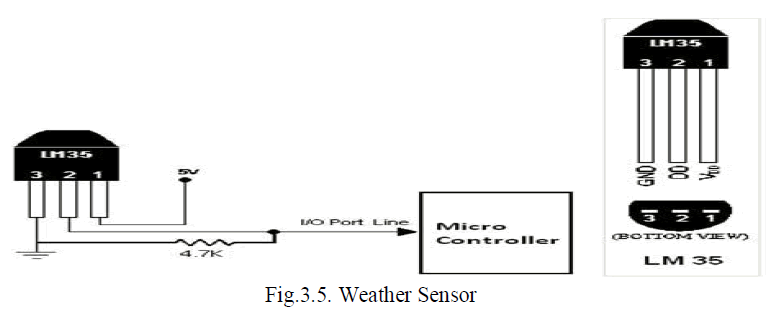 |
3.5. Humidity Sensor |
| A device consisting of a special plastic material whose electrical characteristics changes according to the amount of humidity in the air. Humidity is the amount of water vapour in the air. Water vapour is the gaseous state of water and is invisible.[1] Humidity indicates the likelihood of precipitation, dew, or fog. Higher humidity reduces the effectiveness of sweating in cooling the body by reducing the rate of evaporation of moisture from the skin. This effect is calculated in a heat index table or humidor, used during summer weather. |
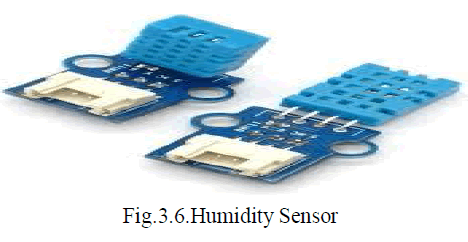 |
3.6. Light Sensor |
| A device that detects the amount of light in the vicinity. An ambient light sensor may be built into a Smartphone or tablet to adjust the screen brightness based on the available light. When light falls on this sensor it changes to electrical energy. For example a street light has a light sensor on its top. The light sensor works in the night and the day. Let's say it's daytime. |
| There is a lot of light coming into the sensor so the electricity is turned off. At the end of the day as it gets dark, the amount of light energy coming in to the light sensor decreases, and that means the electrical current is turned on to light the lamp. So the sensor controls the electrical supply. |
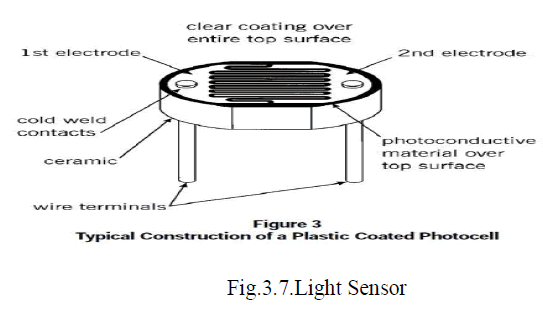 |
3.7. Gas Sensor |
| A gas detector is a device which detects the presence of various gases within an area, often as part of a safety system. This type of equipment is used to detect a gas leak and interface with a control system so a process can be automatically shut down. |
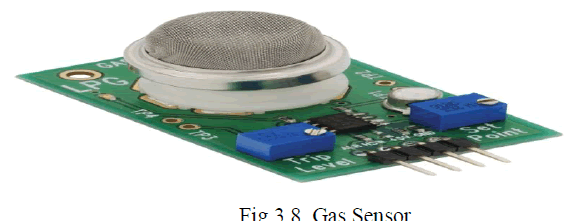 |
3.8 Proposed system images |
| The aim of this project is to provide an efficient solution for automatic control of irrigation motor for illiterates. Now a day’s technology is running with time, it completely occupied the life style of human beings. Even though there is such an importance for technology in our routine life there are even people whose life styles are very far to this well known term technology. So it is our responsibility to design few reliable systems which can be even efficiently used by them. This basic idea gave birth to the project cell phone controlled soil moisture sensor. Here the automation process is done through the micro controller based technology. |
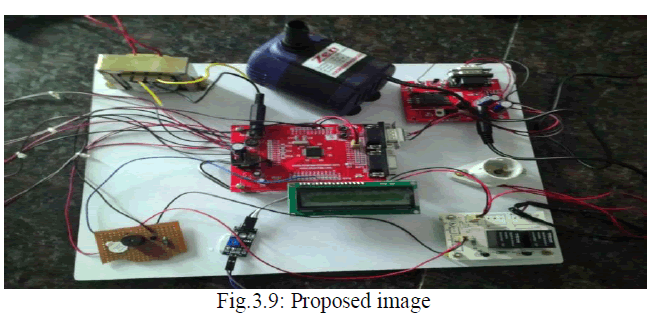 |
IV.CONCLUSION |
| Our proposed System successfully utilizes wireless technology and monitoring, control the effects of electricity (light, heat, gas.co2 and so on) often are taken for granted in our domestic homes. In order to support increased awareness in the area of consumer energy consumption, on a large scale in society as well as on the mundane level of the home. |
References |
|